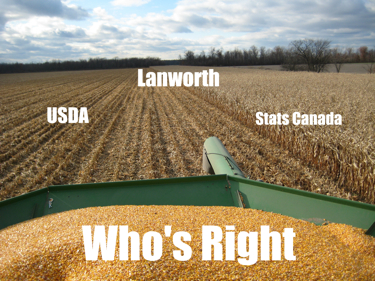
One of the most reviled statistics this past year was the 1.823 million acre Ontario corn number that Statistics Canada published this past spring. For several months before that estimate was published many professional Ontario grain traders were musing about 1.6 or 1.7 million acres of Ontario corn in 2009. Now with frost coming into Ontario earlier than we had hoped and similar reports coming out of Michigan, it makes me wonder just how good these numbers are.
There are similar numbers coming out of the United States. For instance on October 9th we will learn just how many corn and soybeans the USDA counts this month. I expect them to boost both figures in the October report and then reduce those figures in November December January. Of course it is all a guessing game but with corn having gained significantly over the last month it makes you wonder what is up?
In the past couple of weeks I’ve had several conversations with former colleagues and others in the agricultural industry that are quite intrigued with this year’s crop estimates. For instance one farmer I talked to did not believe the USDA corn estimate of 12.955 billion bushels. Then at the recent Outdoor Farm Show near Woodstock Ontario I was openly questioned about the Lanworth estimates. When I was presented with the word “Lanworth” it didn’t ring a bell. So I told the individual I had not heard of them. However I quickly corrected myself because in fact I had heard of them through DTN. To the parochial world of grain prognosticators, Lanworth is like Google showing up for a party with IBM.
If you still don’t get what I’m talking about, Lanworth describes themselves like this.
“Operating out of offices in Itasca, Illinois, the integrated team at Lanworth enables effective decisions based on factual resource intelligence. Derived from constant satellite monitoring, extensive field sampling and expert modeling; our intelligence is accurate, timely, and independent that reaches a variety of industry sectors: financial institutions, hedge funds, agriculture procurement and price/risk management, forestry, real estate, and energy”.
What is significant about Lanworth is this year their estimates is saying the North American crop is much worse than our friends at USDA. For instance, they are saying that the US corn crop will average 153.8 bushels per acre versus 159.5 bushels per acre from the USDA. Lanworth’s estimate of soybeans is 6% below the USDA August estimate. Clearly, there is something going on here. The question is if Lanworth is right, what is the USDA doing?
I certainly don’t want to yell fire in a crowded theater. However, according to Lanworth over the last two years, by the end of the season USDA crop production estimates were within 1% of Lanworth estimates. It’s pretty obvious to get to that point this year we have to have a major turnaround in those USDA numbers.
Of course all of this was complicated over the past week, as Ontario has seen two major frost events. The first event happened on the weekend of September 20th, much of the corn and soybeans in western Ontario were exposed to freezing temperatures and that was followed up with widespread frost on September 30th. Ditto for much of the American eastern Corn Belt. Essentially what has happened is frost has come two weeks early to a crop, which was two weeks behind. Visions of low-test weight corn and high moisture content are dancing on my brain.
As I write this Statistics Canada is on the verge of announcing their September crop estimates. Everybody who watches is expecting a much bigger canola estimate than the 9.5 million tons, which were reported in the August report. I’ll sure be interested to see if they ever change those 1.823 million acres of Ontario corn. Of course we have the USDA chiming in on October 9th. However with Lanworth’s numbers jingling around in my brain, I’ve got to think there is a better way. Can’t we use better technology, which is independent of political interference to get better market information?
Of course if you were to ask Lanworth, I’m sure they would concur. However, I would look for a Canadian solution for Canadian acres. It is not out of the realm of possibility that with the new technology available right on my computer desktop we can have a “made in Canada” to our crop estimate needs.
2009 might be a watershed moment for this technology. It is entirely obvious to me as well as many people in discussion forums across the agricultural cyber world that these crop estimates aren’t quite adding up this year. Put a little frost in the mix and it can surely lead to some market fireworks.
In the next six weeks the end of this story will surely be written. Who is right and by how much and how did they get there? That makes the next two weeks critical in terms of early harvested results. Everybody I talk to wants to tell me the crop isn’t there. Hmmm, I’m bearish by nature, but based on these fickle crop estimates maybe this is the year the naysayers are right.